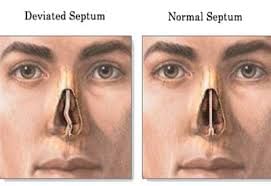Deviated Nasal Septum!
Treatment of Deviated Nasal Septum
Homeopathic Treatment of Deviated Nasal Septum
Acupuncture & Acupressure Treatment of Deviated Nasal Septum
Psychotherapy Treatment of Deviated Nasal Septum
Conventional / Allopathic Treatment of Deviated Nasal Septum
Surgical Treatment of Deviated Nasal Septum
Dietary & Herbal Treatment of Deviated Nasal Septum
Other Treatment of Deviated Nasal Septum
What is Deviated Nasal Septum
Symptoms of Deviated Nasal Septum
Causes of Deviated Nasal Septum
Risk factors of Deviated Nasal Septum
Complications of Deviated Nasal Septum
Lab Investigations and Diagnosis of Deviated Nasal Septum
Precautions & Prevention of Deviated Nasal Septum
Treatment of Deviated Nasal Septum
Homeopathic Treatment of Deviated Nasal Septum
Homeopathic Treatment of Deviated Nasal Septum will remove the side effects which you face such as the sinus infection, congestion, nose bleeds and headaches. It helps sinus congestion that triggers a lot of pressure in the head. Some of the homeopathic remedies for deviated nasal septum are:
Kali bi
Silicea
Calcarea
Pulsatilla
Conventional / Allopathic Treatment of Deviated Nasal Septum
In the allopathic treatment of Deviated Nasal Septum, the medications used are Decongestants, Antihistamines and Nasal steroid sprays. These medications reduce nasal congestion, helping to keep the airways on both sides of your nose open. They also help to prevent many cold and allergy symptoms, including runny nose. Corticosteroid sprays can reduce inflammation in your nasal passage and help prevent a runny nose.
Surgical Treatment of Deviated Nasal Septum
The surgical procedure to correct a Deviated Nasal Septum is Septoplasty. During septoplasty, your nasal septum is repositioned in the center of your nose. This may require your surgeon to cut and remove parts of your septum before reinserting it in the proper position.
Dietary & Herbal Treatment of Deviated Nasal Septum
Eat less dairy products
Eat diet rich in magnesium and calcium
Other Treatment of Deviated Nasal Septum
Boil water in a container and take steam from it regularly. This will help clear the nasal passage
Deep breathing exercises help to remove blockage from the nose
What is Deviated Nasal Septum?
A deviated nasal septum occurs when the thin wall between your nostrils is displaced to one side. A centered septum allows air to flow equally through each nostril. In a deviated nasal septum the wall is not centered..
Symptoms of Deviated Nasal Septum
Obstruction of one or both nostrils
Nose bleeding
Headache
Facial pain
Noisy breathing during sleep
Frequent or recurring sinus infections
Causes of Deviated Nasal Septum
It occurs during fetal development and is apparent at birth
Injury that causes the nasal septum to be knocked out of position
Risk factors of Deviated Nasal Septum
Not wearing your seat belt while riding in a motorized vehicle
Contact sports without appropriate protective headgear
Complications of Deviated Nasal Septum
Nasal obstruction
Sinus infections
Nosebleeds
Facial pain and headaches
Diagnosis of Deviated Nasal Septum
The doctor will ask about your symptoms such as nosebleeds or nasal congestion and ask whether you’ve had any trauma to your nose and also ask about your medical history. A physical exam will be done. The doctor will examine the nasal passages. A nasal speculum will hold the nose open. A thin telescope is passed into the nose.
Precautions & Prevention of Deviated Nasal Septum
Wear a helmet when playing contact sports, such as football and hockey
Wear seat belts in automobiles and airplanes



+1.svg)
